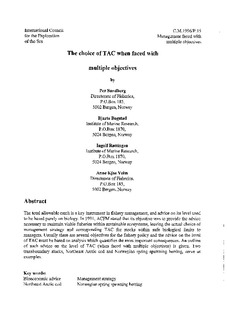| dc.contributor.author | Sandberg, Per | |
| dc.contributor.author | Bogstad, Bjarte | |
| dc.contributor.author | Røttingen, Ingolf | |
| dc.contributor.author | Veim, Anne Kjos | |
| dc.date.accessioned | 2012-09-28T12:16:26Z | |
| dc.date.available | 2012-09-28T12:16:26Z | |
| dc.date.issued | 1996 | |
| dc.identifier.citation | This report is not to be cited without prior reference to the authors | no_NO |
| dc.identifier.uri | http://hdl.handle.net/11250/105641 | |
| dc.description.abstract | The total allowable catch is a key instrument in fishery management, and advice on its level used
to be based purely on biology. In 1991, ACFM stated that its objective was to provide the advice
necessary to maintain viable fisheries within sustainable ecosystems, leaving the actual choice of
management strategy and corresponding TAC for stocks within safe biological limits to
managers. Usually there are several objectives for the fishery policy and the advice on the level
of TAC must be based on analysis which quantifies the most important consequences. An outline
of such advice on the level of TAC (when faced with multiple objectives) is given. Two
transboundary stocks, Northeast Arctic cod and Norwegian spring spawning herring, serve as
examples. | no_NO |
| dc.language.iso | eng | no_NO |
| dc.publisher | ICES | no_NO |
| dc.relation.ispartofseries | ICES CM Documents;1996/P:15 | |
| dc.subject | fisheries regulations | no_NO |
| dc.subject | fiskerireguleringer | no_NO |
| dc.subject | management advice | no_NO |
| dc.subject | forvaltningsråd | no_NO |
| dc.title | The choice of TAC when faced with multiple objectives | no_NO |
| dc.type | Working paper | no_NO |
| dc.subject.nsi | VDP::Agriculture and fishery disciplines: 900::Fisheries science: 920::Catch: 925 | no_NO |
| dc.subject.nsi | VDP::Social science: 200::Library and information science: 320::Knowledge retrieval and organization: 323 | no_NO |
| dc.source.pagenumber | 18 s. | no_NO |
